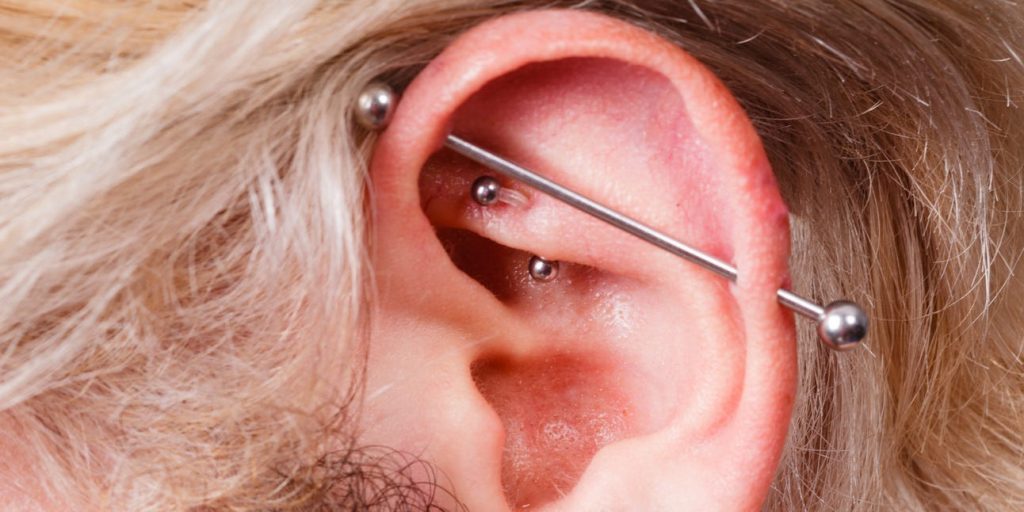- A rook piercing goes through the cartilage fold between your ear canal and the top rim of your ear.
- It costs between $30 to $80 and can take about 6-9 months to fully heal.
- Because the rook piercing goes through a double-layer of cartilage, it can be painful.
- Visit Insider's Health Reference library for more advice.
A rook piercing is a type of ear piercing that goes through the uppermost cartilage fold that lies between your ear canal and the top rim of your ear.
The rook piercing is one of the most painful ear piercings because it passes through a double layer of cartilage — this means it may take extra long to heal too.
Here's what a rook piercing feels like, how you can care for it, and what to look out for.
What is a rook piercing?
Since a rook piercing is more involved compared to your typical lobe or helix piercing, there are some key facts you should know before getting the procedure.
- Price: The price of a rook piercing can vary widely, depending on where you live and the piercing shop you go to. On average, they may cost anywhere from $30 to $80.
- Healing time: Cartilage takes longer to heal than a standard earlobe piercing, "Rook piercings on average take about 6-9 months to fully heal," says Paul Fox, a professional piercer, educator, and member of the Association of Professional Piercers (APP).
- Pain level: A rook piercing feels like a sharp pinch, followed by soreness in your ear. It may also cause a feeling of pressure, "kind of like someone is pulling or tugging on that part of the ear," says Kate McGaffney, a professional piercer and APP member. You won't get this feeling of pressure with most other ear piercings, and some people have rated the pain as high as seven out of ten.
- Materials: For any new piercing, it's best to stick with hypoallergenic metals. The APP recommends several options, including surgical steel, titanium, gold, or glass. It's also best to use jewelry with extra room on each side of your cartilage, like a hoop or long bar — this way your ear has room to swell while healing.
How to care for a rook piercing
There are a few important steps you should follow to make sure your rook piercing heals well and doesn't develop any complications like infection.
1. Don't touch it
"The most difficult, but most important part of healing any piercing is leaving it alone!" McGaffney says. Touching, twisting, and picking at a new piercing can lead to complications like infection, says McGaffney.
2. Clean it regularly
It's also important to follow a cleaning routine about three times per day for the first six months after getting your rook piercing. To clean your rook piercing. Fox recommends following these steps:
-
- Wash your hands before touching the piercing.
- With the piercing still in your ear, spray a sterile saline solution on it to rinse the piercing. You can find this at any pharmacy, but be sure to choose a product that's labeled as a wound wash.
- If the saline is running into your ear canal, you can also soak a piece of gauze with the saline and gently wipe the piercing.
- Carefully pat the piercing dry with gauze or a clean paper towel.
3. Be careful while sleeping
It's important to avoid sleeping on the piercing for the first four to six months. "Travel pillows are helpful for keeping the pressure of your head off the piercing," McGaffney says.
You should also be careful to keep the piercing clean — "pillowcases should be changed regularly and wet hair should be dried or tied up before bed," McGaffney says.
4. Wait to change your jewelry
Once your piercing is fully healed, you can change out the jewelry. "Changing a rook piercing can be very tricky, even if it's fully healed, and should be done by a professional," Fox says.
Certain types of jewelry can put you at greater risk of injuring a piercing. "Dangly jewelry or snug fitted rings should be avoided. We recommend waiting a year for this type of jewelry," Fox says.
Side effects of a rook piercing
Some of the common side effects you may feel right after getting a rook piercing include:
- Swelling
- Bleeding
- Soreness
- Bruising
"Soreness shouldn't last more than a few days," McGaffney says.
Once these symptoms fade, you may develop some itching and the piercing may secrete a whitish–yellow fluid that forms a crust on the piercing. This is normal and a sign of healing, but you should resist the urge to scratch it, as this can interfere with healing or increase your risk of infection.
However, some key signs that your piercing may be infected include:
- Severe swelling, pain, or redness
- It produces large amounts of green or yellow pus
- Red streaks spreading from the piercing site
- Your symptoms get worse after a week
If you see any of these symptoms, call your piercer or see a doctor as soon as possible. Leaving an infected rook piercing untreated could lead to an larger abscess filled with pus or a systemic infection, in which the infection spreads throughout your body]
Insider's takeaway
Rook piercings are a type of cartilage piercing that can take a long time to fully heal. Taking proper care of your piercing can help the healing process and prevent complications like infection.
As with any piercing, "people should look for a professional, knowledgeable, and skillful piercer," Fox says. The APP member locator can help connect you with qualified professional piercers — you can find someone in your area on their website.
